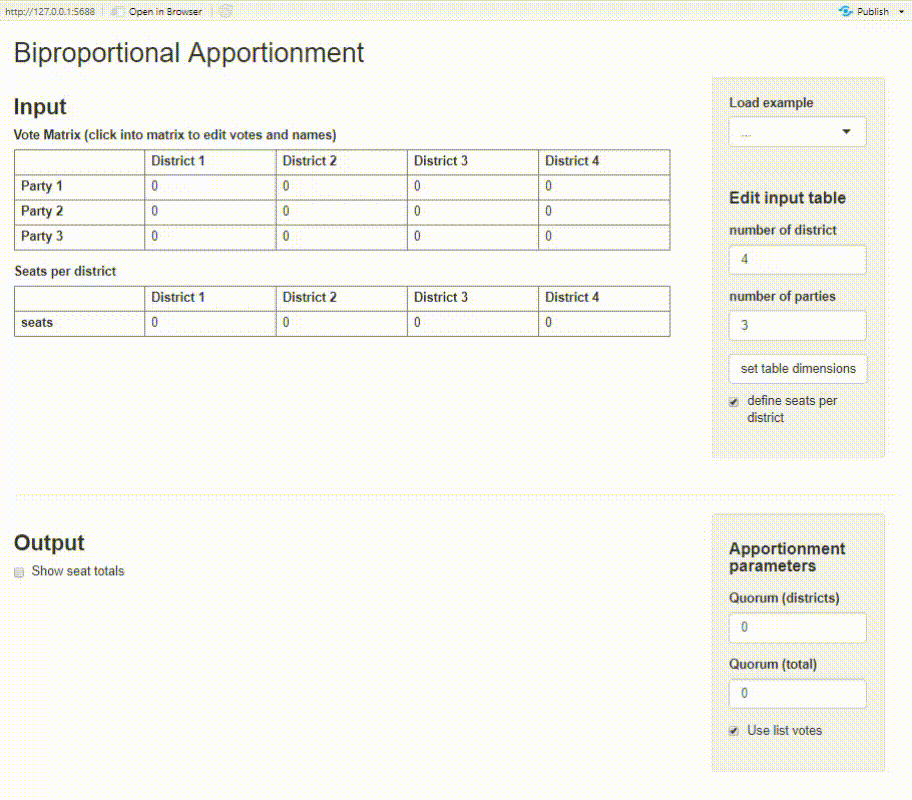Proportional Apportionment.
proporz 
Calculate seat apportionment for legislative bodies with various methods. These methods include divisor methods (e.g. D'Hondt, Webster or Adams), largest remainder methods and biproportional apportionment.
Mit diesem R-Package können mittels verschiedener Sitzzuteilungsverfahren Wählerstimmen in Abgeordnetensitze umgerechnet werden. Das Package beinhaltet Quoten-, Divisor- und biproportionale Verfahren (Doppelproporz oder "Doppelter Pukelsheim").
Installation
Install the package from CRAN:
install.packages("proporz")
Alternatively, install the development version from Github:
# install.packages("remotes")
remotes::install_github("polettif/proporz")
Apportionment methods overview
Proportional Apportionment
proporz() distributes seats proportionally for a vector of votes according to the following methods:
- Divisor methods (Wikipedia)
- D'Hondt, Jefferson, Hagenbach-Bischoff
- Sainte-Laguë, Webster
- Adams
- Dean
- Huntington-Hill
- Largest remainder method (Wikipedia)
- Hare-Niemeyer, Hamilton, Vinton
library(proporz)
votes = c("Party A" = 651, "Party B" = 349, "Party C" = 50)
proporz(votes, n_seats = 10, method = "sainte-lague")
#> Party A Party B Party C
#> 7 3 0
proporz(votes, 10, "huntington-hill", quorum = 0.05)
#> Party A Party B Party C
#> 6 4 0
Biproportional Apportionment
Biproportional apportionment (Wikipedia) is a method to proportionally allocate seats among parties and districts.
We can use the provided uri2020 data set to illustrate biproportional apportionment with biproporz(). You need a 'votes matrix' as input which shows the number of votes for each party (rows) and district (columns). You also need to define the number of seats per district.
(votes_matrix <- uri2020$votes_matrix)
#> Altdorf Bürglen Erstfeld Schattdorf
#> CVP 11471 2822 2309 4794
#> SPGB 11908 1606 1705 2600
#> FDP 9213 1567 946 2961
#> SVP 7756 2945 1573 3498
(district_seats <- uri2020$seats_vector)
#> Altdorf Bürglen Erstfeld Schattdorf
#> 15 7 6 9
biproporz(votes_matrix, district_seats)
#> Altdorf Bürglen Erstfeld Schattdorf
#> CVP 5 2 2 3
#> SPGB 4 1 2 2
#> FDP 3 1 1 2
#> SVP 3 3 1 2
You can use pukelsheim() for dataframes in long format as input data. It is a wrapper for biproporz(). zug2018 shows an actual election result for the Canton of Zug in a dataframe. We use this data set to create input data for pukelsheim(). The other parameters are set to reflect the actual election system.
# In this data set, parties are called 'lists' and districts 'entities'.
votes_df = unique(zug2018[c("list_id", "entity_id", "list_votes")])
district_seats_df = unique(zug2018[c("entity_id", "election_mandates")])
seats_df = pukelsheim(votes_df,
district_seats_df,
quorum = quorum_any(any_district = 0.05, total = 0.03),
winner_take_one = TRUE)
head(seats_df)
#> list_id entity_id list_votes seats
#> 1 2 1701 8108 2
#> 2 1 1701 2993 0
#> 3 3 1701 19389 3
#> 4 4 1701 14814 2
#> 5 5 1701 4486 1
#> 6 6 1701 15695 3
The Apportionment scenarios vignette contains more examples. How to adapt biproporz for special use cases is demonstrated in the Modifying biproporz() vignette.
Shiny app
The package provides a basic Shiny app where you can calculate biproportional apportionment on an interactive dashboard. You need to have the packages shiny and shinyMatrix installed. Try it out on shinyapps.io
# install.packages("shiny")
# install.packages("shinyMatrix")
proporz::run_app()

Function details
Divisor methods
You can use divisor methods directly:
votes = c("Party A" = 690, "Party B" = 370, "Party C" = 210, "Party D" = 10)
# D'Hondt, Jefferson or Hagenbach-Bischoff method
divisor_floor(votes, 10)
#> Party A Party B Party C Party D
#> 6 3 1 0
# Sainte-Laguë or Webster method
divisor_round(votes, 10)
#> Party A Party B Party C Party D
#> 5 3 2 0
# Adams method
divisor_ceiling(votes, 10)
#> Party A Party B Party C Party D
#> 4 3 2 1
# Dean method
divisor_harmonic(votes, 10)
#> Party A Party B Party C Party D
#> 5 2 2 1
# Huntington-Hill method
divisor_geometric(votes, 10)
#> Party A Party B Party C Party D
#> 5 3 1 1
Largest remainder method
The largest remainder method is also accessible directly:
votes = c("I" = 16200, "II" = 47000, "III" = 12700)
# Hamilton, Hare-Niemeyer or Vinton method
largest_remainder_method(votes, 20)
#> I II III
#> 4 13 3
See also
There are other R packages available that provide apportionment functions, some with more focus on analysis. However, biproportional apportionment is missing from the pure R packages and RBazi needs rJava with an accompanying jar.
- RBazi: Package using rJava to access the functions of BAZI.
- seatdist: Package for seat apportionment and disproportionality measurement.
- disprr: Simulate election results and examine disproportionality of apportionment methods.
- apportR: Package containing various apportionment methods, with particular relevance for the problem of apportioning seats in the House of Representatives.
- apportion: Convert populations into integer number of seats for legislative bodies, focusing on the United States.
Contributing
Please feel free to issue a pull request or open an issue.